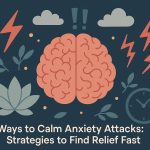As parents, ensuring the health and safety of our children is a top priority. While we often focus on visible dangers like sharp objects or unsafe play areas, hidden threats like black mold can pose serious risks to our children’s well-being. Black mold, scientifically known as Stachybotrys chartarum, is a toxic fungus that thrives in damp, humid environments. Exposure to black mold can lead to a range of health issues, particularly in children, whose developing immune systems make them more vulnerable. This parental guide explores the dangers of black mold exposure, the top warning signs of mold illness in children, and practical steps parents can take to protect their families.
What Is Black Mold, and Why Is It Dangerous?
Black mold is a type of fungus that grows in moist, warm, and poorly ventilated areas, such as bathrooms, basements, or areas affected by water damage. It releases tiny spores into the air, which can be inhaled or come into contact with skin. These spores produce mycotoxins, toxic substances that can cause health problems, especially in children, who may be more sensitive due to their smaller size, developing lungs, and weaker immune systems.
Children are particularly at risk because they spend more time indoors, often in close proximity to potential mold sources, such as damp carpets, walls, or air conditioning units. Prolonged exposure to black mold can lead to respiratory issues, allergic reactions, and, in severe cases, neurological or immune system complications. Recognizing the warning signs early is critical for protecting your child’s health.
Top Warning Signs of Black Mold Exposure in Children
The symptoms of black mold exposure can mimic other common childhood illnesses, making it challenging to identify without careful observation. Below are the top warning signs parents should watch for:
1. Persistent Respiratory Symptoms
Coughing and Wheezing: A chronic, dry cough or wheezing that doesn’t improve with typical treatments (e.g., for asthma or allergies) may indicate mold exposure. Children may complain of tightness in their chest or difficulty breathing due to mold cough from any recent exposure.
Frequent Sinus Infections or Nasal Congestion: Runny noses, sinus pressure, or recurrent sinus infections that linger beyond a typical cold could be linked to mold. Black mold spores irritate the mucous membranes, leading to inflammation.
Shortness of Breath: In severe cases, children may experience shortness of breath, especially during physical activity or in damp environments.
What to Watch For: If your child’s respiratory symptoms worsen in specific areas of your home (e.g., the basement or bathroom) or improve when they’re away from home, mold exposure could be the culprit.
2. Allergic Reactions
Sneezing and Itchy Eyes: Mold spores are potent allergens. Children may experience frequent sneezing, watery or itchy eyes, or a scratchy throat, even outside of allergy season.
Skin Rashes or Irritation: Contact with mold or its spores can cause red, itchy, or inflamed skin. Look for rashes that appear suddenly and don’t respond to typical treatments like hydrocortisone cream.
Hives or Eczema Flare-Ups: Children with pre-existing allergies or eczema may notice worsening symptoms in moldy environments.
What to Watch For: Allergic reactions that seem to occur only in certain rooms or after spending time in damp areas may point to mold exposure.
3. Fatigue and Weakness
Unexplained Tiredness: Black mold exposure can cause chronic fatigue, even in otherwise active children. This may manifest as difficulty waking up, low energy during play, or complaints of feeling “drained.”
Difficulty Concentrating: Mycotoxins can affect cognitive function, leading to trouble focusing on schoolwork or activities. Parents may notice their child seems unusually foggy or forgetful.
If your child’s energy levels drop without an obvious cause (e.g., lack of sleep or poor diet), consider environmental factors like mold.
4. Frequent Headaches
- Recurring Headaches or Migraines: Mold exposure can trigger headaches, ranging from mild to severe, due to inflammation or irritation of the nervous system. Children may describe a “pressure” in their head or sensitivity to light and sound.
- Dizziness or Lightheadedness: In some cases, children may feel dizzy or unsteady, especially after prolonged exposure.
What to Watch For: Headaches that occur consistently in certain environments (e.g., at home but not at school) may suggest mold as a trigger.
5. Gastrointestinal Issues
- Nausea or Vomiting: Inhaling or ingesting mold spores can irritate the digestive system, leading to nausea, vomiting, or stomach pain.
- Loss of Appetite: Children exposed to mold may lose interest in food or complain of feeling full quickly.
Gastrointestinal symptoms paired with other signs, like respiratory issues, should raise suspicion of mold exposure.
6. Neurological Symptoms
- Irritability or Mood Changes: Mycotoxins can affect the central nervous system, leading to mood swings, irritability, or even anxiety in children.
- Memory Problems or Confusion: In severe cases, children may struggle with memory or seem confused, though this is less common.
Behavioral changes that seem out of character or worsen in specific environments should prompt further investigation.
7. Immune System Suppression
- Frequent Illnesses: Children exposed to black mold may catch colds, flu, or other infections more often due to a weakened immune system.
- Slow Recovery: If your child takes longer than usual to recover from minor illnesses, mold exposure could be compromising their immune response.
A pattern of recurring infections or prolonged recovery times may indicate an environmental toxin like mold.
How to Confirm Black Mold Exposure
If you suspect your child is experiencing symptoms related to black mold exposure, take the following steps:
Inspect Your Home: Look for visible signs of mold, such as black, green, or grayish patches on walls, ceilings, or floors. Check areas prone to moisture, like bathrooms, basements, or under sinks. A musty odor is another red flag.
Consult a Pediatrician: Share your concerns with your child’s doctor. Be specific about symptoms, their duration, and any patterns (e.g., symptoms worsening at home). The doctor may recommend allergy testing or blood tests to check for mycotoxin exposure.
Hire a Professional Mold Inspector: A certified mold inspector can assess your home for hidden mold and measure spore levels in the air. They can also identify the type of mold, as not all molds are toxic.
Monitor Symptoms: Keep a journal of your child’s symptoms, noting when and where they occur. This can really help your doctor or inspector pinpoint mold as the cause of illness.
Preventing and Addressing Black Mold Exposure
Protecting your child from black mold requires proactive measures to prevent mold growth and address any existing issues. Here’s what parents can do:
1. Control Moisture in Your Home
- Fix Leaks Promptly: Repair any leaky pipes, roofs, or windows to prevent water damage.
- Use a Dehumidifier: Keep your indoor humidity below 50% to discourage mold growth. Dehumidifiers are especially useful in basements and bathrooms.
- Ventilate Properly: Ensure that your bathrooms, kitchens, and laundry rooms have proper ventilation. Use exhaust fans or open windows when cooking or showering.
2. Clean and Remove Mold Safely
- Small Areas: For minor mold growth (less than 10 square feet), clean with a mixture of water and mild detergent or a commercial mold cleaner. Wear gloves and a mask to avoid exposure.
- Large Infestations: For extensive mold, hire a professional remediation service. Attempting to remove large amounts of mold yourself can release spores into the air, worsening exposure.
3. Improve Indoor Air Quality
- Use Air Purifiers: HEPA air purifiers can help remove mold spores from the air.
- Regularly Clean HVAC Systems: Ensure air conditioning units and heating systems are cleaned and maintained to prevent mold growth in ducts.
4. Educate Your Family
- Teach children to report musty smells or visible mold in the home. Encourage them to avoid touching or disturbing moldy areas.
5. Monitor Your Child’s Health
- If symptoms persist after removing mold, consult an environmental medicine specialist or allergist for further evaluation. Some children may need specific treatments to recover from prolonged exposure.
When to Seek Immediate Medical Attention
In rare cases, exposure to black mold can lead to severe health issues, particularly in children with pre-existing conditions like asthma or weakened immune systems. Seek immediate medical care if your child experiences:
- Severe difficulty breathing or persistent wheezing
- High fever with respiratory symptoms
- Confusion, seizures, or loss of consciousness
- Severe allergic reactions, such as swelling or difficulty swallowing
The Importance of Awareness for Parents
Black mold is a hidden danger that can go unnoticed until it causes significant health problems. By staying in the know and recognizing the warning signs of exposure, parents can take swift action to protect their children. Regular home maintenance, prompt repairs, and open communication with healthcare providers are key to keeping your family safe.
If you suspect black mold in your home, don’t delay—act quickly to investigate and remediate the issue. Your child’s health depends on a safe, mold-free environment. For additional mold resources or professional black mold removal help, contact a local and certified mold remediation company or check out the Environmental Protection Agency (EPA) for guidance on mold prevention and cleanup. By staying informed and proactive, you can ensure your home remains a healthy sanctuary for your children.
Lynn Martelli is an editor at Readability. She received her MFA in Creative Writing from Antioch University and has worked as an editor for over 10 years. Lynn has edited a wide variety of books, including fiction, non-fiction, memoirs, and more. In her free time, Lynn enjoys reading, writing, and spending time with her family and friends.















